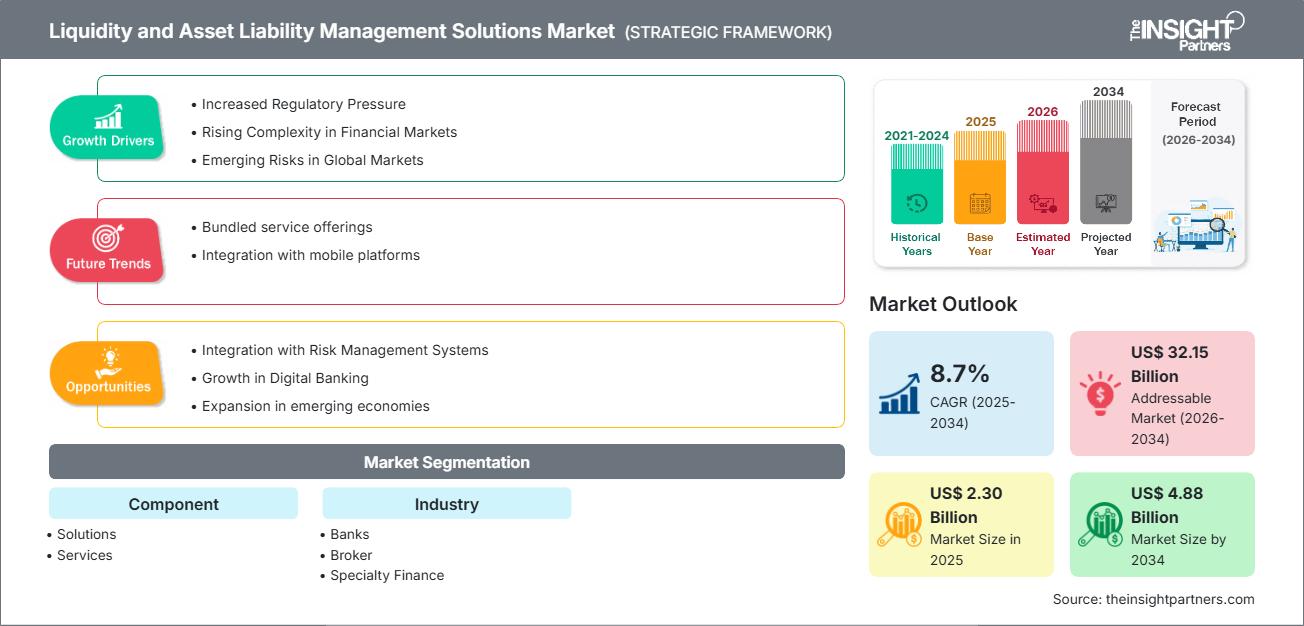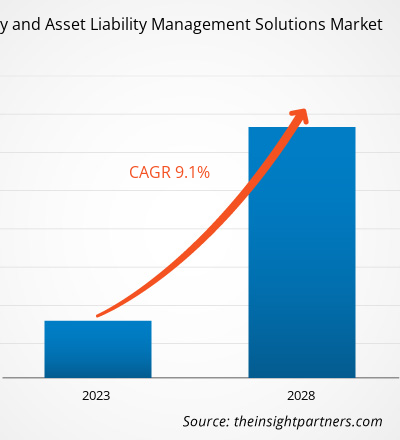预计流动性和资产负债管理 (ALM) 解决方案市场将从 2025 年的 23 亿美元增长到 2034 年的 48.8 亿美元,预测期内复合年增长率为 8.7%。
流动性和资产负债管理解决方案市场分析
金融机构日益增长的信用风险以及监管机构对利率风险不断加大的压力,正在推动流动性和资产负债管理(ALM)解决方案市场的发展。银行和其他金融机构利用此类解决方案进行情景分析,更有效地管理资产负债表,并满足不断提高的资本和融资要求。高级ALM解决方案包含一个FTP模块,使机构能够计算业务各个层面的盈利能力。
例如,美国、英国和日本等全球利率波动加剧,给净息差带来了更大的压力,使得有效的资产负债管理至关重要。
流动性和资产负债管理解决方案市场概览
流动性管理是指确保拥有足够的现金和流动资产来履行义务。与之相对,资产负债管理则涉及协调资产和负债的期限、利率和规模,以最大限度地降低风险并优化盈利能力。
流动性和资产负债管理解决方案帮助金融机构有效地建模和控制这些动态,从而实现基于风险的决策、预测、监管合规和绩效优化。
根据您的需求定制此报告
您可以免费获得任何报告的定制服务,包括本报告的部分内容、国家/地区层面的分析、Excel 数据包,以及面向初创企业和高校的优惠折扣。
流动性和资产负债管理解决方案市场:战略洞察

-
获取本报告的主要市场趋势。这份免费样品将包含数据分析,内容涵盖市场趋势、估算和预测等。
流动性和资产负债管理解决方案市场驱动因素和机遇
市场驱动因素:
- 金融机构信用风险上升:违约率上升、贷款组合压力增大以及宏观环境不确定,迫使金融机构采取解决方案来管理流动性和利率风险。
- 监管压力:大多数监管规定,包括 IRRBB(银行账簿利率风险)、融资计划压力测试和资本风险框架,都迫使银行执行复杂的资产负债管理模型。
- 利率环境波动:全球利率波动压缩利润空间,从而增加了有效资产负债管理以保障盈利能力的必要性。
- 数字化与分析:机构越来越依赖数据分析、情景模拟和资产负债管理预测来进行决策。
机会:
- AI/机器学习在风险建模中的应用:先进的AI驱动的资产负债管理工具可以改进预测、流动性压力测试和情景管理。
- 基于云的 ALM 平台:云部署可以帮助机构更灵活地扩展 ALM 系统,同时降低基础设施成本。
- 与财务系统集成:ALM 工具可以与财务、风险和资金转移定价系统集成,以创建统一的决策框架。
- 新兴市场扩张:随着新兴经济体(例如亚太地区)的银行业务增长,它们对先进流动性和资产负债管理解决方案的需求也在增加。
流动性和资产负债管理解决方案市场报告细分分析
按组件:
- 解决方案
- 服务
按行业/机构类型:
- 银行
- 经纪人
- 专业金融
- 财富顾问
- 其他的
按地理位置:
- 北美
- 欧洲
- 亚太
- 南美洲和中美洲
- 中东和非洲
流动性和资产负债管理解决方案市场区域洞察
The Insight Partners 的分析师对预测期内影响流动性和资产负债管理解决方案市场的区域趋势和因素进行了详尽的阐述。本节还探讨了北美、欧洲、亚太地区、中东和非洲以及南美和中美洲等地区的流动性和资产负债管理解决方案市场细分及地域分布。
流动性和资产负债管理解决方案市场报告范围
| 报告属性 | 细节 |
|---|---|
| 2025年市场规模 | 23亿美元 |
| 到2034年市场规模 | 48.8亿美元 |
| 全球复合年增长率(2025-2034 年) | 8.7% |
| 史料 | 2021-2024 |
| 预测期 | 2026-2034 |
| 涵盖部分 |
按组件
|
| 覆盖地区和国家 |
北美
|
| 市场领导者和主要公司简介 |
|
流动性和资产负债管理解决方案市场参与者密度:了解其对业务动态的影响
流动性和资产负债管理解决方案市场正快速增长,这主要得益于终端用户需求的不断增长,而终端用户需求的增长又源于消费者偏好的转变、技术的进步以及消费者对产品优势认知的提高。随着需求的增长,企业不断拓展产品和服务,持续创新以满足消费者需求,并把握新兴趋势,这些都进一步推动了市场增长。

- 获取流动性和资产负债管理解决方案市场主要参与者概览
流动性和资产负债管理解决方案市场份额分析(按地域划分)
- 北美:得益于先进的银行基础设施、完善的监管体系以及对集成风险管理平台的需求,该技术得到了广泛应用。
- 欧洲:监管要求和成熟的金融机构推动了资产负债管理 (ALM) 的采用;压力测试和利率风险要求是关键。
- 亚太地区:预计将成为快速增长的地区。银行业规模的不断扩大、数字化转型以及风险意识的增强,都在推动资产负债管理(ALM)的需求。
- 南美洲和中美洲:资产负债管理的新兴市场,由不断增长的银行业风险管理需求驱动。
- 中东和非洲:金融服务普及率的提高和监管的成熟为资产负债管理解决方案提供商带来了机遇。
流动性和资产负债管理解决方案市场参与者密度:了解其对业务动态的影响
流动性及资产负债管理(ALM)解决方案市场的竞争日趋激烈。主要参与者包括大型全球金融软件公司以及区域性专业公司。为了脱颖而出,供应商采取了以下策略:
- 提供集成的资产负债管理 (ALM) + 流动性风险平台,具备 FTP、情景分析和压力测试功能。
- 结合分析、人工智能和预测建模,提供前瞻性的风险洞察。
- 提供基于云的 ALM 服务,以降低采用成本并提高可扩展性。
- 与银行和金融机构合作,根据当地监管和市场需求定制资产负债管理系统。
在流动性和资产负债管理解决方案市场运营的主要公司:
- Experian 信息软件公司
- 富达国民信息服务公司
- 芬纳斯特拉国际有限公司
- IBM公司
- 印孚瑟斯有限公司
- 英特尔设计竞技场有限公司
- 穆迪公司
- 甲骨文公司
- SAP SE
研究期间分析的其他公司
- FIS Global
- SAS研究所
- Fiserv公司
- 埃森哲公司
- 毕马威会计师事务所
- 德勤
- 普华永道
- 安永
- Protiviti公司
- 阿尔瓦雷斯和马萨尔
流动性和资产负债管理解决方案市场新闻及最新动态
- 数字化转型举措:金融机构越来越多地使用实时分析、云资产负债管理 (ALM) 和人工智能驱动的工具来改善流动性预测和风险管理。
- 监管压力测试要求:随着全球资本和流动性监管的日益严格,银行正在加大对资产负债管理 (ALM) 系统的投资,以支持监管压力测试、银行账簿利率风险 (IRRBB) 和资金转移定价。
- 合作伙伴关系与实施:例如,2022 年 6 月,Infosys Finacle(EdgeVerve)与一家银行合作实施了其财务和资产负债管理平台,展示了集成风险流动性系统的部署。
流动性和资产负债管理解决方案市场报告涵盖范围和成果
The Insight Partners发布的《流动性与资产负债管理解决方案市场规模及预测(2021-2034)》报告包含以下内容:
- 全球、区域和国家层面所有关键细分市场的市场规模和预测
- 详细的市场动态:驱动因素、制约因素和机遇
- PEST 和 SWOT 分析
- 战略洞察:趋势、监管影响和竞争分析
- 行业格局:市场集中度、主要参与者热力图、近期战略举措
- 领先和新兴ALM解决方案提供商的详细公司简介
- 历史分析(2 年)、基准年、预测(7 年)及复合年增长率
- PEST和SWOT分析
- 市场规模、价值/数量 - 全球、区域、国家
- 行业和竞争格局
- Excel 数据集
近期报告
客户评价
购买理由
- 明智的决策
- 了解市场动态
- 竞争分析
- 客户洞察
- 市场预测
- 风险规避
- 战略规划
- 投资论证
- 识别新兴市场
- 优化营销策略
- 提升运营效率
- 顺应监管趋势






















 获取免费样品 - 流动性和资产负债管理解决方案市场
获取免费样品 - 流动性和资产负债管理解决方案市场